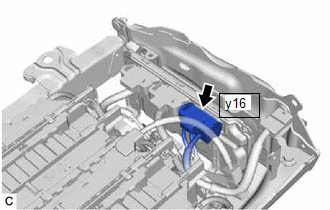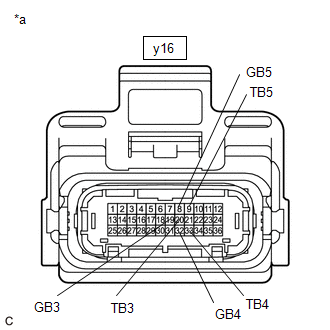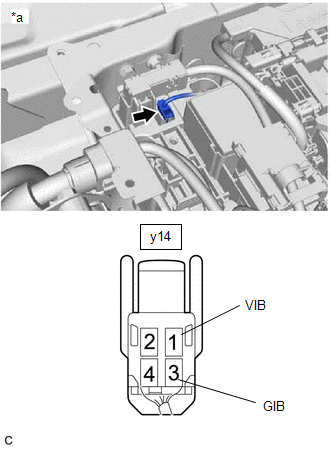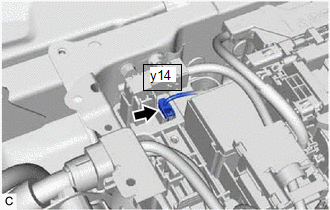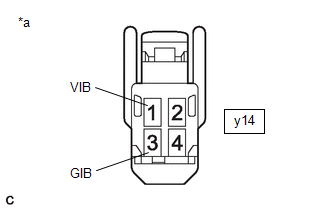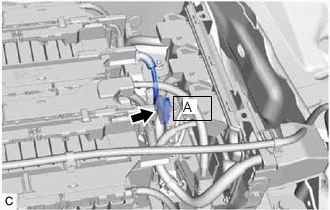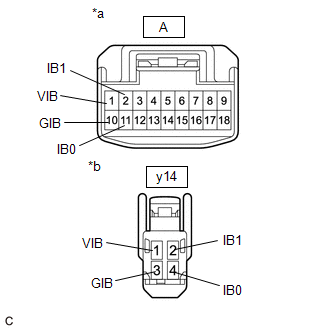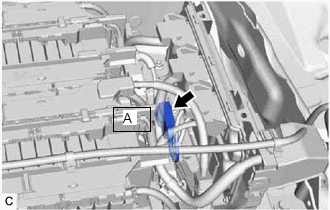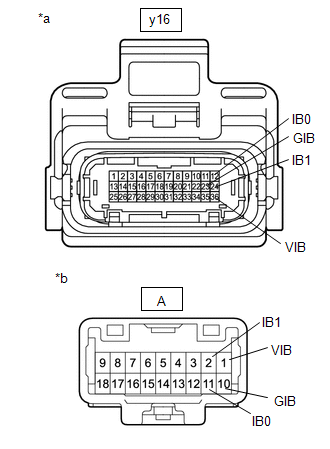Lexus ES: Hybrid/EV Battery Temperature Sensor "A" Circuit Short to Ground (P0A9B11,...,P0C3315)
DESCRIPTION
The battery temperature sensors are provided at 6 locations of the HV battery. The resistance of the thermistor, which is built into each battery temperature sensor, varies in accordance with changes in the HV battery temperature. The lower the battery temperature, the higher the thermistor resistance. Conversely, the higher the temperature, the lower the resistance. The battery ECU assembly uses the battery temperature sensors to detect the HV battery temperature. Based on the results of this detection, the battery ECU assembly controls the blower fan. (The blower fan starts when the HV battery temperature rises above a predetermined level.)
Temperature Sensor Identification Cross Reference Table:
| DTC Title Sensor | Battery Temperature Sensor | Techstream Display |
|---|---|---|
| A | 0 | 1 |
| B | 1 | 2 |
| C | 2 | 3 |
| D | 3 | 4 |
| E | 4 | 5 |
| F | 5 | 6 |
HINT:
Use the reference table above to determine which battery temperature sensor corresponds to each DTC. For example, sensor A in the DTC title column is battery temperature sensor 0. This sensor is displayed as Hybrid/EV Battery Temperature 1 in the Data List.
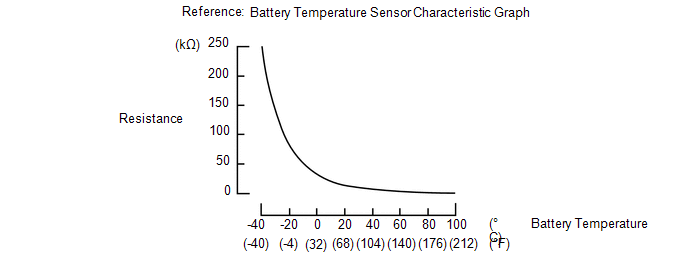
| DTC No. | Detection Item | DTC Detection Condition | Trouble Area | MIL | Warning Indicate |
|---|---|---|---|---|---|
| P0A9B11 | Hybrid/EV Battery Temperature Sensor "A" Circuit Short to Ground | The battery temperature sensor is malfunctioning, its output voltage is lower than the specified value (short circuit) and the detected temperature is higher than the specified value. (1 trip detection logic) |
| Comes on | Master Warning Light: Comes on |
| P0A9B15 | Hybrid/EV Battery Temperature Sensor "A" Circuit Short to Auxiliary Battery or Open | The battery temperature sensor is malfunctioning, its output voltage is higher than the specified value (short to +B or open) and the detected temperature is lower than the specified value. (1 trip detection logic) |
| Comes on | Master Warning Light: Comes on |
| P0AC511 | Hybrid/EV Battery Temperature Sensor "B" Circuit Short to Ground | The battery temperature sensor is malfunctioning, its output voltage is lower than the specified value (short circuit) and the detected temperature is higher than the specified value. (1 trip detection logic) |
| Comes on | Master Warning Light: Comes on |
| P0AC515 | Hybrid/EV Battery Temperature Sensor "B" Circuit Short to Auxiliary Battery or Open | The battery temperature sensor is malfunctioning, its output voltage is higher than the specified value (short to +B or open) and the detected temperature is lower than the specified value. (1 trip detection logic) |
| Comes on | Master Warning Light: Comes on |
| P0ACA11 | Hybrid/EV Battery Temperature Sensor "C" Circuit Short to Ground | The battery temperature sensor is malfunctioning, its output voltage is lower than the specified value (short circuit) and the detected temperature is higher than the specified value. (1 trip detection logic) |
| Comes on | Master Warning Light: Comes on |
| P0ACA15 | Hybrid/EV Battery Temperature Sensor "C" Circuit Short to Auxiliary Battery or Open | The battery temperature sensor is malfunctioning, its output voltage is higher than the specified value (short to +B or open) and the detected temperature is lower than the specified value. (1 trip detection logic) |
| Comes on | Master Warning Light: Comes on |
| P0AE811 | Hybrid/EV Battery Temperature Sensor "D" Circuit Short to Ground | The battery temperature sensor is malfunctioning, its output voltage is lower than the specified value (short circuit) and the detected temperature is higher than the specified value. (1 trip detection logic) |
| Comes on | Master Warning Light: Comes on |
| P0AE815 | Hybrid/EV Battery Temperature Sensor "D" Circuit Short to Auxiliary Battery or Open | The battery temperature sensor is malfunctioning, its output voltage is higher than the specified value (short to +B or open) and the detected temperature is lower than the specified value. (1 trip detection logic) |
| Comes on | Master Warning Light: Comes on |
| P0BC211 | Hybrid/EV Battery Temperature Sensor "E" Circuit Short to Ground | The battery temperature sensor is malfunctioning, its output voltage is lower than the specified value (short circuit) and the detected temperature is higher than the specified value. (1 trip detection logic) |
| Comes on | Master Warning Light: Comes on |
| P0BC215 | Hybrid/EV Battery Temperature Sensor "E" Circuit Short to Auxiliary Battery or Open | The battery temperature sensor is malfunctioning, its output voltage is higher than the specified value (short to +B or open) and the detected temperature is lower than the specified value. (1 trip detection logic) |
| Comes on | Master Warning Light: Comes on |
| P0C3311 | Hybrid/EV Battery Temperature Sensor "F" Circuit Short to Ground | The battery temperature sensor is malfunctioning, its output voltage is lower than the specified value (short circuit) and the detected temperature is higher than the specified value. (1 trip detection logic) |
| Comes on | Master Warning Light: Comes on |
| P0C3315 | Hybrid/EV Battery Temperature Sensor "F" Circuit Short to Auxiliary Battery or Open | The battery temperature sensor is malfunctioning, its output voltage is higher than the specified value (short to +B or open) and the detected temperature is lower than the specified value. (1 trip detection logic) |
| Comes on | Master Warning Light: Comes on |
| DTC No. | Data List |
|---|---|
| P0A9B11 | Hybrid/EV Battery Temperature 1 to 6 |
| P0A9B15 | |
| P0AC511 | |
| P0AC515 | |
| P0ACA11 | |
| P0ACA15 | |
| P0AE811 | |
| P0AE815 | |
| P0BC211 | |
| P0BC215 | |
| P0C3311 | |
| P0C3315 |
HINT:
-
After checking for the above DTCs, check the hybrid system Data List item "Hybrid/EV Battery Temperature" using the Techstream.
Temperature Displayed
Malfunction
Below -45°C (-49°F)
Open or +B short circuit
95°C (203°F) or more
GND short circuit
- If the vehicle as is left as is for 24 hours, the value of "Hybrid/EV Battery Temperature" will be almost the same as the ambient temperature.
MONITOR DESCRIPTION
If the battery ECU assembly detects a malfunction in a HV battery temperature sensor, the battery ECU will illuminate the MIL and store a DTC.
MONITOR STRATEGY
| Related DTCs | P0A9D (INF P0A9B11), P0AC7 (INF P0AC511), P0ACC (INF P0ACA11), P0AEA (INF P0AE811), P0BC4 (INF P0BC211), P0C35 (INF P0C3311): Battery temperature sensor circuit malfunction (GND short) P0A9E (INF P0A9B15), P0AC8 (INF P0AC515), P0ACD (INF P0ACA15), P0AEB (INF P0AE815), P0BC5 (INF P0BC215), P0C36 (INF P0C3315): Battery temperature sensor circuit malfunction (open) |
| Required sensors/components | Battery temperature sensor |
| Frequency of operation | Continuous |
| Duration | TMC's intellectual property |
| MIL operation | Immediately |
| Sequence of operation | None |
TYPICAL ENABLING CONDITIONS
| The monitor will run whenever the following DTCs are not stored | TMC's intellectual property |
| Other conditions belong to TMC's intellectual property | - |
TYPICAL MALFUNCTION THRESHOLDS
| TMC's intellectual property | - |
COMPONENT OPERATING RANGE
| Battery ECU assembly | DTC P0A9D (INF P0A9B11) is not detected DTC P0AC7 (INF P0AC511) is not detected DTC P0ACC (INF P0ACA11) is not detected DTC P0C83 (INF P0C8111) is not detected DTC P0BC4 (INF P0BC211) is not detected DTC P0C35 (INF P0C3311) is not detected DTC P0A9E (INF P0A9B15) is not detected DTC P0AC8 (INF P0AC515) is not detected DTC P0ACD (INF P0ACA15) is not detected DTC P0AEB (INF P0AE815) is not detected DTC P0BC5 (INF P0BC215) is not detected DTC P0C36 (INF P0C3315) is not detected |
CONFIRMATION DRIVING PATTERN
HINT:
-
After repair has been completed, clear the DTC and then check that the vehicle has returned to normal by performing the following All Readiness check procedure.
Click here
.gif)
-
When clearing the permanent DTCs, refer to the "CLEAR PERMANENT DTC" procedure.
Click here
.gif)
- Connect the Techstream to the DLC3.
- Turn the power switch on (IG) and turn the Techstream on.
- Clear the DTCs (even if no DTCs are stored, perform the clear DTC procedure).
- Turn the power switch off and wait for 2 minutes or more.
- Turn the power switch on (IG) and turn the Techstream on.
-
With power switch on (IG) and wait for 10 seconds or more.[*1]
HINT:
[*1]: Normal judgment procedure.
The normal judgment procedure is used to complete DTC judgment and also used when clearing permanent DTCs.
- Enter the following menus: Powertrain / HV Battery / Utility / All Readiness.
-
Check the DTC judgment result.
HINT:
- If the judgment result shows NORMAL, the system is normal.
- If the judgment result shows ABNORMAL, the system has a malfunction.
- If the judgment result shows INCOMPLETE or N/A, perform the normal judgment procedure again.
WIRING DIAGRAM
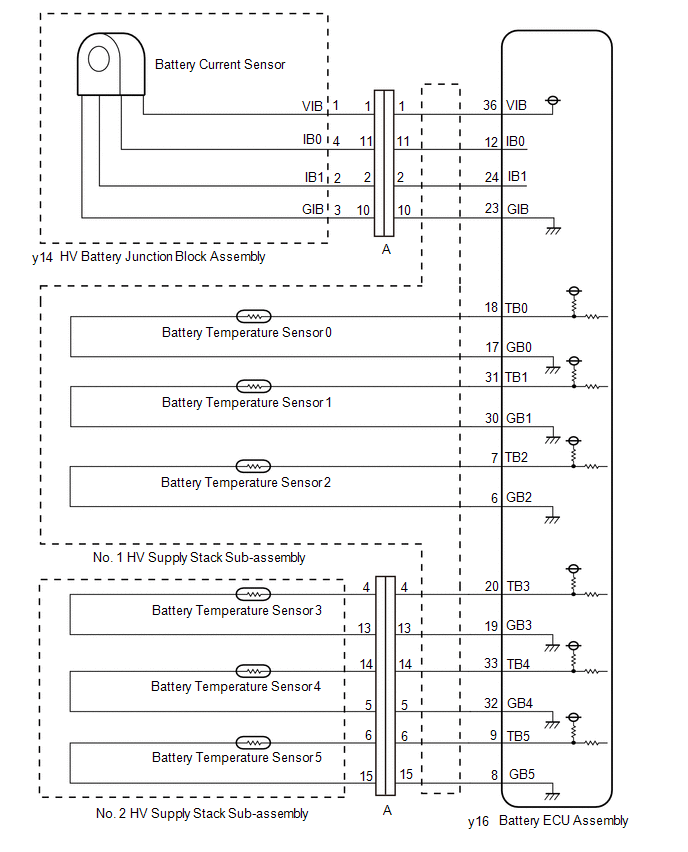
CAUTION / NOTICE / HINT
CAUTION:
-
Before the following operations are conducted, take precautions to prevent electric shock by turning the power switch off, wearing insulated gloves, and removing the service plug grip from HV battery.
.png)
- Inspecting the high-voltage system
- Disconnecting the low voltage connector of the inverter with converter assembly
- Disconnecting the low voltage connector of the HV battery
-
To prevent electric shock, make sure to remove the service plug grip to cut off the high voltage circuit before servicing the vehicle.
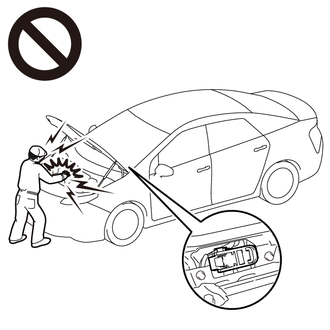
-
After removing the service plug grip from the HV battery, put it in your pocket to prevent other technicians from accidentally reconnecting it while you are working on the high-voltage system.
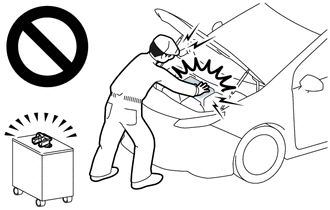
-
After removing the service plug grip, wait for at least 10 minutes before touching any of the high-voltage connectors or terminals. After waiting for 10 minutes, check the voltage at the terminals in the inspection point in the inverter with converter assembly. The voltage should be 0 V before beginning work.
Click here
.gif)
.gif)
HINT:
Waiting for at least 10 minutes is required to discharge the high-voltage capacitor inside the inverter with converter assembly.
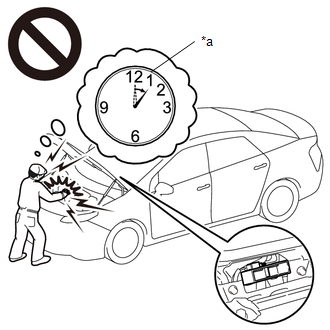
*a
Without waiting for 10 minutes
-
When disposing of an HV battery, make sure to return it through an authorized collection agent who is capable of handling it safely. If the HV battery is returned via the manufacturer specified route, it will be returned properly and in a safe manner by an authorized collection agent.
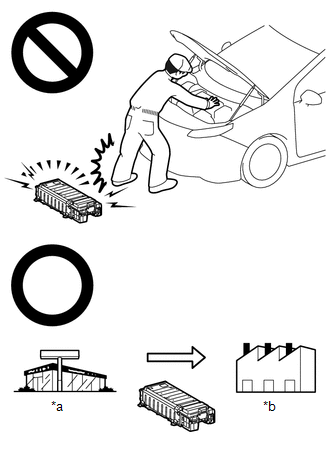
*a
Dealer
*b
Battery Collection Agent
- Accidents such as electric shock may result if the HV battery is disposed of improperly or abandoned. Therefore, make sure to return all HV batteries through an authorized collection agent.
-
Before returning the HV battery, make sure to perform a recovery inspection.
Click here
.gif)
-
Before returning the HV supply stack sub-assembly, make sure to perform a recovery inspection.
Click here
.gif)
- Make a note of the output DTCs as some of them may be necessary for recovery inspection of the HV battery and HV supply stack sub-assemblies.
-
After removing the HV battery, keep it away from water. Exposure to water may cause the HV battery to produce heat, resulting in a fire.
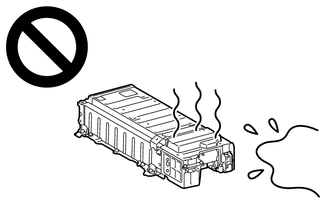
-
Make sure to insulate the high-voltage connectors and terminals of the HV battery with insulating tape after removing it.
If the HV battery stored without insulating the connectors and terminals, electric shock or fire may result.
NOTICE:
After turning the power switch off, waiting time may be required before disconnecting the cable from the negative (-) auxiliary battery terminal. Therefore, make sure to read the disconnecting the cable from the negative (-) auxiliary battery terminal notices before proceeding with work.
Click here .gif)
.gif)
PROCEDURE
| 1. | CHECK DTC OUTPUT (HV BATTERY, HYBRID CONTROL) |
(a) Connect the Techstream to the DLC3.
(b) Turn the power switch on (IG).
(c) Enter the following menus: Powertrain / HV Battery and Hybrid Control / Trouble Codes.
(d) Check for DTCs.
Powertrain > HV Battery > Trouble Codes Powertrain > Hybrid Control > Trouble Codes| Result | Proceed to |
|---|---|
| "P0A9B11, P0A9B15, P0AC511, P0AC515, P0ACA11, P0ACA15, P0AE811, P0AE815, P0BC211, P0BC215, P0C3311 or P0C3315" only is output, or DTCs except the ones in the table below are also output. | A |
| DTCs of hybrid battery system in the table below are output. | B |
| DTCs of hybrid control system in the table below are output. | C |
| System | Relevant DTC | |
|---|---|---|
| Hybrid battery system | P060A47 | Hybrid/EV Battery Energy Control Module Monitoring Processor Watchdog / Safety MCU Failure |
| P060B49 | Hybrid/EV Battery Energy Control Module A/D Processing Internal Electronic Failure | |
| P060687 | Hybrid/EV Battery Energy Control Module Processor to Monitoring Processor Missing Message | |
| Hybrid control system | P0A1F94 | Hybrid/EV Battery Energy Control Module Unexpected Operation |
(e) Turn the power switch off.
| B | .gif) | GO TO DTC CHART (HYBRID BATTERY SYSTEM) |
| C | .gif) | GO TO DTC CHART (HYBRID CONTROL SYSTEM) |
|
| 2. | READ VALUE USING TECHSTREAM (HYBRID/EV BATTERY TEMPERATURE) |
(a) Connect the Techstream to the DLC3.
(b) Turn the power switch on (IG).
(c) Enter the following menus: Powertrain / HV Battery / Data List / Hybrid/EV Battery Temperature 1 to 6.
(d) Read the Data List.
Powertrain > HV Battery > Data List| Tester Display | Measurement Item | Range | Reference Value | Diagnostic Note |
|---|---|---|---|---|
| Hybrid/EV Battery Temperature 1 | HV battery temperature sensor output. | -50 to 205.9°C (-58 to 402.6°F) | Same as ambient temperature (left as is for 24 hours) |
|
| Hybrid/EV Battery Temperature 2 | HV battery temperature sensor output. | -50 to 205.9°C (-58 to 402.6°F) | Same as ambient temperature (left as is for 24 hours) |
|
| Hybrid/EV Battery Temperature 3 | HV battery temperature sensor output. | -50 to 205.9°C (-58 to 402.6°F) | Same as ambient temperature (left as is for 24 hours) |
|
| Hybrid/EV Battery Temperature 4 | HV battery temperature sensor output. | -50 to 205.9°C (-58 to 402.6°F) | Same as ambient temperature (left as is for 24 hours) |
|
| Hybrid/EV Battery Temperature 5 | HV battery temperature sensor output. | -50 to 205.9°C (-58 to 402.6°F) | Same as ambient temperature (left as is for 24 hours) |
|
| Hybrid/EV Battery Temperature 6 | HV battery temperature sensor output. | -50 to 205.9°C (-58 to 402.6°F) | Same as ambient temperature (left as is for 24 hours) |
|
| Tester Display |
|---|
| Hybrid/EV Battery Temperature 1 |
| Hybrid/EV Battery Temperature 2 |
| Hybrid/EV Battery Temperature 3 |
| Hybrid/EV Battery Temperature 4 |
| Hybrid/EV Battery Temperature 5 |
| Hybrid/EV Battery Temperature 6 |
HINT:
A malfunctioning sensor (battery temperature sensor 0, 1, 2, 3, or 5) can be determined by comparing the output temperature of the 6 battery temperature sensors.
(e) Turn the power switch off.
|
| 3. | CHECK CONNECTOR CONNECTION CONDITION (BATTERY ECU ASSEMBLY CONNECTOR) |
CAUTION:
Be sure to wear insulated gloves and protective goggles.
(a) Check that the service plug grip is not installed.
NOTICE:
After removing the service plug grip, do not turn the power switch on (READY), unless instructed by the repair manual because this may cause a malfunction.
(b) Remove the No. 1 HV battery hose.
Click here .gif)
.gif)
| (c) Check the connector connections and contact pressure of the relevant terminals for the battery ECU assembly. Click here OK: The connector is connected securely and there are no contact pressure problems. |
|
(d) Install the No. 1 HV battery hose.
| NG | .gif) | CONNECT SECURELY |
|
| 4. | CHECK DTC |
(a) Check the DTCs that were output when the vehicle was brought to the workshop.
| Result | Proceed to |
|---|---|
| "P0A9B11, P0A9B15, P0AC511, P0AC515, P0ACA11 or P0ACA15" is also output. | A |
| "P0AE811, P0AE815, P0BC211, P0BC215, P0C3311 or P0C3315" is also output. | B |
| B | .gif) | GO TO STEP 6 |
|
| 5. | CHECK HV BATTERY (BATTERY TEMPERATURE SENSOR 0 to 2) |
CAUTION:
Be sure to wear insulated gloves and protective goggles.
(a) Check that the service plug grip is not installed.
NOTICE:
After removing the service plug grip, do not turn the power switch on (READY), unless instructed by the repair manual because this may cause a malfunction.
(b) Remove the No. 1 HV battery hose.
Click here .gif)
.gif)
| (c) Disconnect the y16 battery ECU assembly connector. NOTICE: Before disconnecting the connector, check that it is not loose or disconnected. |
|
| (d) Measure the resistance of the circuit for the malfunctioning sensor (battery temperature sensor 0 to 2). Tester Connection:
Standard Resistance:
|
|
(e) Measure the resistance according to the value (s) in the table below.
Standard Resistance:
| Tester Connection | Condition | Specified Condition |
|---|---|---|
| y16-18 (TB0) - Body ground and other terminals (except y16-17 (GB0)) | Power switch off | 10 kΩ or higher |
| y16-17 (GB0) - Body ground and other terminals (except y16-18 (TB0)) | Power switch off | 10 kΩ or higher |
| y16-31 (TB1) - Body ground and other terminals (except y16-30 (GB1)) | Power switch off | 10 kΩ or higher |
| y16-30 (GB1) - Body ground and other terminals (except y16-31 (TB1)) | Power switch off | 10 kΩ or higher |
| y16-7 (TB2) - Body ground and other terminals (except y16-6 (GB2)) | Power switch off | 10 kΩ or higher |
| y16-6 (GB2) - Body ground and other terminals (except y16-7 (TB2)) | Power switch off | 10 kΩ or higher |
(f) Connect the cable to the negative (-) auxiliary battery terminal.
(g) Turn the power switch on (IG).
(h) Measure the voltage according to the value (s) in the table below.
Standard Voltage:
| Tester Connection | Switch Condition | Specified Condition |
|---|---|---|
| y16-18 (TB0) - Body ground | Power switch on (IG) | Below 1 V |
| y16-17 (GB0) - Body ground | Power switch on (IG) | Below 1 V |
| y16-31 (TB1) - Body ground | Power switch on (IG) | Below 1 V |
| y16-30 (GB1) - Body ground | Power switch on (IG) | Below 1 V |
| y16-7 (TB2) - Body ground | Power switch on (IG) | Below 1 V |
| y16-6 (GB2) - Body ground | Power switch on (IG) | Below 1 V |
NOTICE:
- Turning the power switch on (IG) with the service plug grip removed causes other DTCs to be stored. Clear the DTCs after performing this inspection.
- If the power switch is turned on (IG) with the connectors disconnected, other DTCs will be stored. Be sure to clear the DTCs after the inspection.
(i) Turn the power switch off.
(j) Disconnect the cable from the negative (-) auxiliary battery terminal.
(k) Reconnect the y16 battery ECU assembly connector.
(l) Install the No. 1 HV battery hose.
| OK | .gif) | GO TO STEP 7 |
| NG | .gif) | REPLACE NO. 1 HV SUPPLY STACK SUB-ASSEMBLY |
| 6. | CHECK HV BATTERY (BATTERY TEMPERATURE SENSOR 3 to 5) |
CAUTION:
Be sure to wear insulated gloves and protective goggles.
(a) Check that the service plug grip is not installed.
NOTICE:
After removing the service plug grip, do not turn the power switch on (READY), unless instructed by the repair manual because this may cause a malfunction.
(b) Remove the No. 1 HV battery hose.
Click here .gif)
.gif)
| (c) Disconnect the y16 battery ECU assembly connector. NOTICE: Before disconnecting the connector, check that it is not loose or disconnected. |
|
| (d) Measure the resistance of the circuit for the malfunctioning sensor (battery temperature sensor 3 to 5). Tester Connection:
Standard Resistance:
|
|
(e) Measure the resistance according to the value (s) in the table below.
Standard Resistance:
| Tester Connection | Condition | Specified Condition |
|---|---|---|
| y16-20 (TB3) - Body ground and other terminals (except y16-19 (GB3)) | Power switch off | 10 kΩ or higher |
| y16-19 (GB3) - Body ground and other terminals (except y16-20 (TB3)) | Power switch off | 10 kΩ or higher |
| y16-33 (TB4) - Body ground and other terminals (except y16-32 (GB4)) | Power switch off | 10 kΩ or higher |
| y16-32 (GB4) - Body ground and other terminals (except y16-33 (TB4)) | Power switch off | 10 kΩ or higher |
| y16-9 (TB5) - Body ground and other terminals (except y16-8 (GB5)) | Power switch off | 10 kΩ or higher |
| y16-8 (GB5) - Body ground and other terminals (except y16-9 (TB5)) | Power switch off | 10 kΩ or higher |
(f) Connect the cable to the negative (-) auxiliary battery terminal.
(g) Turn the power switch on (IG).
(h) Measure the voltage according to the value (s) in the table below.
Standard Voltage:
| Tester Connection | Switch Condition | Specified Condition |
|---|---|---|
| y16-20 (TB3) - Body ground | Power switch on (IG) | Below 1 V |
| y16-19 (GB3) - Body ground | Power switch on (IG) | Below 1 V |
| y16-33 (TB4) - Body ground | Power switch on (IG) | Below 1 V |
| y16-32 (GB4) - Body ground | Power switch on (IG) | Below 1 V |
| y16-9 (TB5) - Body ground | Power switch on (IG) | Below 1 V |
| y16-8 (GB5) - Body ground | Power switch on (IG) | Below 1 V |
NOTICE:
- Turning the power switch on (IG) with the service plug grip removed causes other DTCs to be stored. Clear the DTCs after performing this inspection.
- If the power switch is turned on (IG) with the connectors disconnected, other DTCs will be stored. Be sure to clear the DTCs after the inspection.
(i) Turn the power switch off.
(j) Disconnect the cable from the negative (-) auxiliary battery terminal.
(k) Reconnect the y16 battery ECU assembly connector.
(l) Install the No. 1 HV battery hose.
| NG | .gif) | GO TO STEP 11 |
|
| 7. | CHECK BATTERY ECU ASSEMBLY (VIB VOLTAGE) |
CAUTION:
Be sure to wear insulated gloves and protective goggles.
(a) Check that the service plug grip is not installed.
NOTICE:
After removing the service plug grip, do not turn the power switch on (READY), unless instructed by the repair manual because this may cause a malfunction.
(b) Remove the No. 1 HV battery cover panel RH.
Click here .gif)
.gif)
(c) Connect the cable to the negative (-) auxiliary battery terminal.
(d) Turn the power switch on (IG).
| (e) Measure the voltage according to the value(s) in the table below. Standard Voltage:
NOTICE: Turning the power switch on (IG) with the service plug grip removed causes other DTCs to be stored. Clear the DTCs after performing this inspection. |
|
(f) Turn the power switch off.
(g) Disconnect the cable from the negative (-) auxiliary battery terminal.
(h) Install the No. 1 HV battery cover panel RH.
| OK | .gif) | REPLACE BATTERY ECU ASSEMBLY |
|
| 8. | CHECK HV BATTERY JUNCTION BLOCK ASSEMBLY (BATTERY CURRENT SENSOR OUTPUT VOLTAGE) |
CAUTION:
Be sure to wear insulated gloves and protective goggles.
(a) Check that the service plug grip is not installed.
NOTICE:
After removing the service plug grip, do not turn the power switch on (READY), unless instructed by the repair manual because this may cause a malfunction.
(b) Remove the No. 1 HV battery cover panel RH.
Click here .gif)
.gif)
| (c) Disconnect the y14 battery current sensor connector from the HV battery junction block assembly. NOTICE: Before disconnecting the connector, check that it is not loose or disconnected. |
|
(d) Connect the cable to the negative (-) auxiliary battery terminal.
(e) Turn the power switch on (IG).
| (f) Measure the voltage according to the value(s) in the table below. Standard Voltage:
NOTICE:
|
|
(g) Turn the power switch off.
(h) Disconnect the cable from the negative (-) auxiliary battery terminal.
(i) Reconnect the y14 battery current sensor connector to the HV battery junction block assembly.
(j) Install the No. 1 HV battery cover panel RH.
| OK | .gif) | REPLACE HV BATTERY JUNCTION BLOCK ASSEMBLY |
|
| 9. | CHECK HARNESS AND CONNECTOR (NO. 2 HV SUPPLY STACK SUB-ASSEMBLY - HV BATTERY JUNCTION BLOCK ASSEMBLY) |
CAUTION:
Be sure to wear insulated gloves and protective goggles.
(a) Check that the service plug grip is not installed.
NOTICE:
After removing the service plug grip, do not turn the power switch on (READY), unless instructed by the repair manual because this may cause a malfunction.
(b) Remove the No. 1 HV battery hose.
Click here .gif)
.gif)
| (c) Disconnect the A No. 2 HV supply stack sub-assembly connector. NOTICE: Before disconnecting the connector, check that it is not loose or disconnected. |
|
| (d) Disconnect the y14 battery current sensor connector from the HV battery junction block assembly. NOTICE: Before disconnecting the connector, check that it is not loose or disconnected. |
|
| (e) Measure the resistance according to the value(s) in the tables below. Standard Resistance (Check for Open):
Standard Resistance (Check for Short):
|
|
(f) Reconnect the y14 battery current sensor connector to the HV battery junction block assembly.
(g) Reconnect the A No. 2 HV supply stack sub-assembly connector.
(h) Install the No. 1 HV battery hose.
| NG | .gif) | REPLACE NO. 2 HV SUPPLY STACK SUB-ASSEMBLY |
|
| 10. | CHECK HARNESS AND CONNECTOR (BATTERY ECU ASSEMBLY - NO. 1 HV SUPPLY STACK SUB-ASSEMBLY) |
CAUTION:
Be sure to wear insulated gloves and protective goggles.
(a) Check that the service plug grip is not installed.
NOTICE:
After removing the service plug grip, do not turn the power switch on (READY), unless instructed by the repair manual because this may cause a malfunction.
(b) Remove the No. 1 HV battery hose.
Click here .gif)
.gif)
| (c) Disconnect the A No. 1 HV supply stack sub-assembly connector. NOTICE: Before disconnecting the connector, check that it is not loose or disconnected. |
|
| (d) Disconnect the y16 battery ECU assembly connector. NOTICE: Before disconnecting the connector, check that it is not loose or disconnected. |
|
| (e) Measure the resistance according to the value(s) in the tables below. Standard Resistance (Check for Open):
Standard Resistance (Check for Short):
|
|
(f) Reconnect the y16 battery ECU assembly connector.
(g) Reconnect the A No. 1 HV supply stack sub-assembly connector.
(h) Install the No. 1 HV battery hose.
| OK | .gif) | REPLACE BATTERY ECU ASSEMBLY |
| NG | .gif) | REPLACE NO. 1 HV SUPPLY STACK SUB-ASSEMBLY |
| 11. | CHECK HARNESS AND CONNECTOR (BATTERY ECU ASSEMBLY - NO. 1 HV SUPPLY STACK SUB-ASSEMBLY) |
Click here .gif)
| OK | .gif) | REPLACE NO. 2 HV SUPPLY STACK SUB-ASSEMBLY |
| NG | .gif) | REPLACE NO. 1 HV SUPPLY STACK SUB-ASSEMBLY |

.gif)
